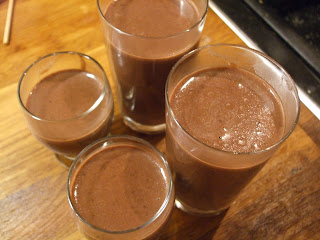So I had a plan to make pea and ham soup and it was inspired in part, by my grandma's amazing ability to take a ham bone and a handful of pulses and transform them from humble ingredients into something magnificent. Yes, there is a possibility that my memory of grandma's soup has been embellished in my own mind with a faint sprinkling of nostalgia, but what is certain is that it was the antidote to cold and dark winter nights and it was a meal in itself, transported from her home to ours in a Thermos flask, dished up, then consumed with gusto, sat at the table at home, and it was the best soup I have ever had. But then, put me in a Michelin starred restaurant and serve me up a consomme made from the tears of mermaids (or something) and I know which soup I will be yearning for.
Anyway, you'd think such humble food would be easy to source wouldn't you? A ham shank and split peas? Not a bloody chance. I went to two supermarkets to buy green split peas (my split pea of choice) and you would think I had gone shopping for the aforementioned tears of mermaids. If I'd wanted adzuki beans or farro then I could have filled my trolley. Split green peas? Nope. And it wasn't that they'd sold out; no gaping chasm labelled green split peas could be found. Pffft. And you probably know already that if you want any meat other than skinless chicken breast, go to a proper butcher. The asking for an uncooked ham hock will often result in a disappointing answer. I abandoned all hope and came home to google.
Anyway, to cut an increasingly long rant story very, very short, a bit of googling came up with pea and ham soup made with frozen peas, Marco Pierre White stylee. And whilst it was nothing like what my grandma used to make, it was very green and very tasty. If I could say it was sweet and salty without that statement sounding revolting, that's exactly what it was. And whilst the colour 'green' is an anathema to Finn in particular when it comes to food, he entertained this a little when I told him it was liquidised monster. He didn't clear his plate; he rarely does. But he ate the ham and some of the soup before declaring that enough was enough.
Since then, I have found split peas. The challenge to recreate the best soup I ever had is back on.
Pea and Ham Soup adapted from Marco Pierre White's recipe
Serves Lola, Finn, Mum and Dad twice
Ingredients:
1 x knuckle of smoked gammon (it will weigh approx 1.3kg) (I used a large ham hock)
2 sticks celery
2 large carrots, halved
4 onions, halved
1 sprig thyme
2 bay leaves
12 white peppercorns (I used black peppercorns)
Salt to taste
1.2kg Bird's Eye peas
40g unsalted butter (I didn't use this)
Method:
Make a stock by placing the gammon into a large saucepan, along with the celery, carrot, onion, thyme, bay leaves, peppercorns and two large pinches of salt. Cover with cold water, put the lid on the pan and bring to the boil.
When boiling, immediately reduce the heat to a gentle simmer.
After 20 minutes, use a slotted spoon to skim off the scum from the water's surface.
Continue to simmer for about 11/2 hours, topping up with warm water if necessary. After two hours, turn off the heat.
Carefully remove the hot ham from the saucepan and place it on a carving board. Carve the joint while it is still hot and cut the slices into bite-sized pieces. These will later be used in the soup.
Sieve the stock, discarding the vegetables, peppercorns, thyme and bay leaves. Allow the liquid to cool before chilling it in the fridge.
Thaw the peas until semi-defrosted, and then liquidise them with the chilled stock.
Pass the pea and stock purée through a sieve. (I just blitzed it - a bit of texture is just fine for me!)











































